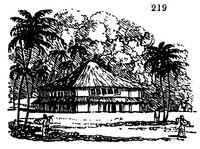778. Malacca abounds in beautiful and odoriferous trees and exquisite fruits. From reminiscences of a visit to Malacca, by Mr. Main, inserted in the Gardener's Magazine, we learn that the ᆭschynomene grandiflora, the Tectona indica, Barringtonia speciosa, many species of palms, and particularly the Michelia Champaca, a showy and odoriferous tree, give a character of great richness to the masses of wood. But the catalogue of fruits transcends every thing of the kind, perhaps, in India; for, besides the fruits common every where in the East, they have the Artocarpus integrifolia, Anonas, and the Carica Papaya, in great perfection. Of the latter, it may be remarked that, though in the class Di£cia, both male and female plants produce fruit, only the female tree always bears the largest. The fruit weighs about two pounds each; may be eaten with sugar, as melons, but is chiefly used as kitchen fruit. But, of all the delicious fruits in India, none can equal, in purity and delicacy of pulp, richness of flavour, and refreshing coolness of juice, those which follow. The mangosteen, Garcinia Mangostana, is here in the greatest perfection, growing wild in the woods. It is said to be the most salubrious of fruits. The eatable part is a transparent pulp, surrounding the seeds. The calyx and stigma are both permanent till the fruit is ripe. There are four other kinds of fruit, probably of the same genus; viz. the duku, an egg-shaped fruit, about the size of. an apricot, and, in flavour, little inferior to the mangosteen ; the courangi, a small fruit, common at Malacca; the shell is brittle, and encloses one seed, surrounded by a spongy melting substance, of an agreeable acid flavour, like that of the tamarind ; the baduc, or jambosteen, which is, in flavour and internal structure, like the mangosteen; the fruit is white, with a slight tincture of pink colour, and it grows in bunches, like the fruit of the potato; and the rambosteen, Nephelium (burdock) lappaceum (bur-like). This last-mentioned fruit is very beautiful, and has an echinated capsule of a bright scarlet colour; the pulp is transparent and most delicious, surrounding one seed. Malacca is said to be favourable for the culture of the coffee; the berries grown there being superior to those of Java or Sumatra. Very picturesque villas and cottages have been formed by the British in most of the East Indian settlements. We may cite, as an example, Dr. M'Kinnon's cottage (fig. 219.), on Prince of Wales's Island, or Pulo Penang. The cottage is thatched with palm-leaves. Town-houses and large country-houses are commonly flat-roofed; and the roof, shaded by an awning, serves as a banqueting-place.
[Editor's note: Malacca is also known as Negeri Bersejarah or Negeri Hang Tuahand is now a state in Malaysia]

